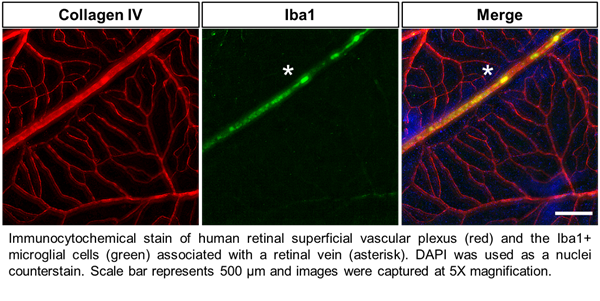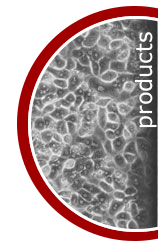Human Ocular Cells
Corneal Epithelial Progenitor Cells
The outermost layer of the cornea is comprised of the cornea epithelium, which acts as a protective barrier for the eye. To defend against foreign pathogens and external injury, corneal epithelial cells secrete a variety of paracrine factors to promote the proper immune response and tight junction formation. Cornea epithelial cells are constantly proliferating and shedding, and are replaced by cornea epithelial progenitor cells from the limbal region of the cornea. In healthy cornea, cornea epithelial progenitor cells migrate from the limbal region of the cornea, and eventually proliferate and differentiate into stratified cornea epithelial cells. In diseased and injured corneas, corneal epithelial progenitor cells are commonly defective and are not able to replace damaged cornea epithelium. Corneal epithelial progenitor cells are used for toxicology and drug screening studies to determine aspects of cell proliferation, migrate and differentiation needed to reconstruct damaged cornea epithelium. Human corneal epithelial progenitor cells are isolated from the enzymatic digestion of the limbal region of the human cornea.
Retinal Endothelial Cells
The walls of retinal microvasculature are composed of a single layer of endothelial cells. Due to their location at the interface between circulating blood in the lumen and the surrounding tissue, retinal endothelial cells are highly active and closely involved in numerous physiological processes. Nutrients such as oxygen and water are able to diffuse through these cells into the surrounding tissue, while the waste products can diffuse into the lumen into the bloodstream for eventual removal. Within diseased retina, retinal endothelial cells undergo pathological angiogenesis and are involved in inflammation processes. Human retinal endothelial cells are used for gene and drug studies to investigate angiogenesis, inflammation, and blood barrier functionality. Retinal endothelial cells are isolated from the eye globes obtained from consented adult volunteer donors.
Retinal Pericytes
Pericytes are mural cells that wrap around capillaries, and are suggested to be multipotent mesenchymal-like cells. Pericytes are important for angiogenesis, the structural integrity of the microvasculature, and blood flow regulation. In some cases of wound healing, pericytes contribute to tissue repair through cell differentiation. Pericytes differentiate into adipocytes during fat tissue injury, chondroblasts and bone after bone injury, and myoblasts in a model for muscle dystrophy. Pericytes have also demonstrated the ability to differentiate into fibroblasts, phagocytes (macrophages), and malignant tumors. Retinal pericyte loss is associated with the progression of retinal diseases, such as diabetic retinopathy, where the loss of these cells leads to vascular dysfunction. Human Retinal Pericytes are used for studies investigating blood-brain barrier functionality, blood vessel maturation, and cell contractility. Human Retinal Pericytes are isolated from the enzymatic digestion and cell sorting of the human retina.
Trabecular Meshwork Cells
The trabecular meshwork is a sponge-like, fibrous tissue that is located underneath the cornea, adjacent to the ciliary body. The trabecular meshwork is responsible for draining the aqueous humor beneath the cornea to the Schlemm's canal, and eventually the blood stream. Inside the trabecular meshwork, the highly phagocytic trabecular meshwork cells remove cell debris from the aqueous humor before the fluid is removed. In diseases such as glaucoma, enlargement and defect of trabecular meshwork cells result in improper drainage of the aqueous humor. Trabecular meshwork cells are used for gene and drug studies to investigate intraocular pressure, phagocytosis, and extracellular matrix remodeling. Trabecular meshwork cells are harvested from outgrowth assays of trabecular meshwork tissue isolated from human corneas.
Retinal Pigment Epithelial Cells
The Human Retinal Pigment Epithelium (RPE) is a pigmented layer of epithelial cells between the retina and the choroid that absorbs scattered light, reduces photo oxidation, and provides overall nourishment to the posterior segment of the eye. RPE cells maintain ocular health by transporting molecules, clearing cellular debris, secreting hormones, and modulating immune factors. The Human RPE layer is isolated from the posterior segment of eyes, and enzymatically dissociated into a single cell suspension that can be cryopreserved and used for ex-vivo research purposes. When the RPE single cell suspension is cultured in vitro, the isolated RPE cells are largely depigmented and exhibit a highly proliferative, fusiform phenotype. These undifferentiated RPE cells can be differentiated into pigmented, mature RPE cells using differentiation media. RPE cells are used for a variety of permeability, biochemical, and physiological assays for basic research and preclinical drug discovery.

Ordering Information:
Human Ocular Cells & Media
| Item# | Item Desc | U / M | Price |
|---|---|---|---|
| HCEPc-F | Cryopreserved Human Corneal Epithelial Progenitor Cells, 0.5 million cells/vial. | Vial | $966.00 |
| CEP-1 | Corneal Epithelial Progenitor Cell Growth Media, 500ml | 500ml | $207.00 |
| CEP-2 | Corneal Epithelial Progenitor Cell Differentiation Media, 50ml (FROZEN) | 50ml | $132.00 |
| CEP-100 | Corneal Epithelial Progenitor Cell Cryopreservation Medium, 100ml (FROZEN) | 100ml | $158.00 |
| HRE-F | Cryopreserved Human Retinal Endothelial Cells, 0.5 million cells/vial. | Vial | $922.00 |
| ECGM-1 | Endothelial Cell Growth Medium, 500ml | 500ml | $192.00 |
| HRP-F | Cryopreserved Human Retinal Pericytes, 0.5 million cells/vial. | Vial | $922.00 |
| PER-1 | Pericyte Growth Medium, 500ml | 500ml | $182.00 |
| HTM-F | Cryopreserved Human Trabecular Meshwork Cells, 0.5 million cells/vial. | Vial | $896.00 |
| TM-1 | Trabecular Meshwork Cell Growth Medium, 500ml | 500ml | $187.00 |
| RPE-F | Cryopreserved Human Retinal Pigment Epithelial Cells, 0.5 million cells/vial. | Vial | $864.00 |
| RPE-1 | Retinal Pigment Epithelial Cell Growth Medium, 500ml | 500ml | $187.00 |
| RPE-2 | Retinal Pigment Epithelial Cell Differentiation Medium, 250ml | 250ml | $284.00 |
| OC-100 | Ocular Cell Cryopreservation Medium, 100ml, (FROZEN)- for RPE-F, HRE-F, HRP-F, HTM-F | 100ml | $158.00 |



